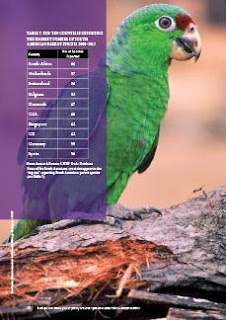The organisation, Traffic, which has expertise on the global trade in wild animals and plants, has just published Bird’s-eye view: Lessons from 50 years of bird trade regulation & conservation in Amazon countries.
In it, author Bernardo Ortiz-von Halle provides a comprehensive overview of bird trade in Brazil, Colombia, Ecuador, Guyana, Peru, and Suriname.
The trade of birds and their products from the region has a long history.
Since the mid-19th Century, many tonnes of feathers and bird skins - mainly hummingbirds and tanagers, were exported to fashion markets in Europe and North America.
This demand led to the killing of millions of birds over many decades.
For example, in a brief period before World War I, a single London merchant imported 400,000 hummingbirds and 360,000 other birds from Brazil, while in 1932, some 25,000 hummingbirds were hunted in Pará State and sent to Italy to adorn chocolate boxes.
After the mid-1950s when commercial airline connections, mainly through Miami, became routinely available, hundreds of thousands of live birds were exported as pets from across South America .
After decades of intensive exploitation and massive declines in many bird populations, Brazil became, in 1967, the first country in South America to impose a ban on the commercial sale of wild-trapped animals.
It sought to fulfil a continuing commercial demand by setting up captive breeding programmes as an economic alternative.
But Brazil's ban resulted in dealers looking to other South American countries to continue their cruel but highly profitable activities.
Exotic birds were still trapped in Brazil, but many were laundered through those countries where exports were still legal - for instance, Argentina, Bolivia and Paraguay.
In the 1980s, up to 10,000 hyacinth macaws were captured, many ending up in captive breeding facilities where production costs were lower than in Brazil.
Wild populations were seriously depleted, though, in recent times, there have been important species recoveries in Brazil thanks to sustained conservation efforts.
However, in Asia, The Phillipines still allows the export of hyacinth macaws.
As the author notes, Brazil has inadvertently produced the opposite situation of a market monopoly - it has unintentionally placed the right to benefit commercially from the trade in its native species in the hands of any other country that chooses to profit from them.
The situation in Brazil - a complete trade ban - was broadly mirrored in Ecuador and Colombia without the parallel development of the captive breeding option.
Now an important economic incentive for conservation of birds in all three countries is through the promotion of birdwatching tourism.
Peru is also actively promoting itself as a birdwatching destination, but, alongside Guyana and Suriname, the country also allows exports of wild-caught examples of some 101 relatively common species.
According to the report, between 2000 and 2013, Peru commercially exported 37,233 birds listed in the Convention on International Trade in Endangered Species of Wild Fauna and Flora (CITES)
The majority of them were two species of parrot - cordilleran parakeet and mitred parakeet.
The document also recognises the current importance of seabird guano as a strategic renewable resource that favours the effective protection of the islands, off Peru, where seabirds nest.
Between 2000 and 2016, Guyana exported 145,000 birds belonging to 24 CITES-listed species, the list being topped by orange-winged Amazon.
Meanwhile, Suriname exported 74,890 parrots between 2000 and 2013.
In Guyana, it is estimated that some 20,000 people, some five per cent of the country’s rural population, benefit from this economic activity.
Although harvest quotas in both countries exist, they have been established without the proper scientific backup to assure the sustainable management of the harvested populations.
Although bans have resulted in a disappearance of birds for sale on the streets of many countries in South America, much of the trade has gone underground.
Peru, both as recipient and source of wild bird species from and to its neighbors, is the biggest regional challenge, though Brazil continues to have a serious problem with internal trade of songbirds despite stringent law enforcement efforts - an average of 30,000–35,000 birds are confiscated each year
Many of these birds are acquired for “songbird competitions” where spectators bet money on the outcomes of how many songs or phrases a bird will sing in a set time period.
This pastime is also popular and legal in Guyana and Suriname (and their expatriate communities living in the USA, Canada and Europe).
Overall,
the study finds that international illegal trade in live South American
birds has been reduced to its lowest level in decades, though this is
“mainly because the bird species most highly sought-after by collectors already exist in most consumer countries.”
The substantial reduction in most South American urban markets that formerly were major illegal bird trade hubs also represents a major conservation achievement.
The substantial reduction in most South American urban markets that formerly were major illegal bird trade hubs also represents a major conservation achievement.
The author notes that “habitat loss remains the greatest threat to wild bird populations in Amazon countries."
* The report can be downloaded via www.traffic.org




No comments:
Post a Comment